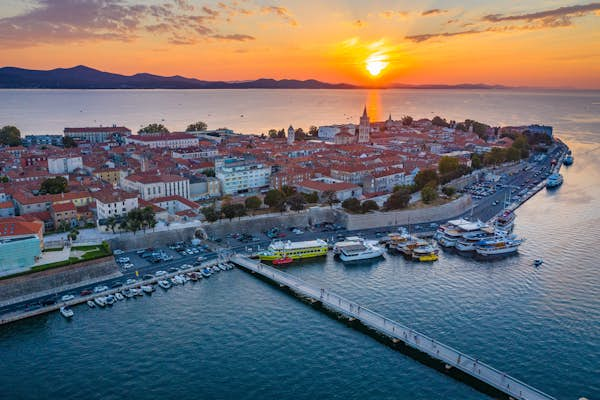Zadar has always been a crossroads for many different peoples and civilizations who have all left their mark on the city. Roman ruins, Venetian fortifications, Romanesque cathedrals, Byzantine churches, and a lingering Italian influence are the relics of its vibrant cultural past.
Today this historic city on Croatia’s Dalmatian coast draws art and history buffs, sea and sun seekers, outdoorsy types, as well as digital nomads hooking up to the city’s 5G network. Visitors mingle on the old town’s lively squares lined with cafes, and along the waterfront promenades, taking in the sights of the old town, or a daytrip to nearby natural hotspots.

Foša and the Land Gate
Most of Zadar’s attractions are found in its compact old town on a narrow peninsula jutting into the Adriatic Sea. Criss-crossing it is a grid-like web of cobblestone lanes laid by the Romans.
Start at Foša, a tiny marina flanked by the imposing Land Gate, once one of the few entrances to the fortified town that was erected by the Venetians in 1543. Look up to spot the winged Lion of Saint Mark, the symbol of the Venetian Republic, peering at you from above the central arched gateway. Sitting on horseback just below him is St Chrysogonus, Zadar’s patron saint.
Kalelarga
As you stroll through the old town, don’t be surprised to find contemporary structures sitting side by side with architectural relics of times past. These modernist constructions of neat geometrical lines were built in the fifties and sixties. This architectural mish-mash is especially noticeable on Široka ulica, the old town’s main thoroughfare, dubbed Kalelarga by locals. Box-like buildings tottering on concrete pillars line this pedestrian street and provide a sheltered walkway for the city’s flaneurs.
Zadar City Walls
In the 16th century, the Venetians fortified the city’s defensive walls on the fragments left behind by the Romans. Called Muraj by locals, the walls were recognized by UNESCO in 2017 as part of the 16th and 17th century Venetian Works of Defense. In 2020 the city walls got an extensive makeover, becoming a pleasant tree-lined promenade dotted with benches and sea-facing viewpoints.
Roman Forum and St Donatus’ Church

Head to Zeleni Trg, the site of the ancient Roman Forum, to admire the city’s oldest and most impressive churches and cathedrals. Dominating this wide square scattered with the stone ruins of ancient buildings in between neat walkways, is St Donatus’ Church. Built in the 9th century, the church is one of the finest examples of Byzantine architecture in Dalmatia. Its imposing circular dome is 88 feet high, and today welcomes congregations of music lovers rather than church goers as an exceptional venue for concerts.
St Anastasia’s Cathedral and Bell Tower
The adjoining St Anastasia’s Cathedral was founded by the Byzantines in the 9th century and rebuilt in Romanesque style between the 12th and 13th centuries. It went through reconstruction again after it was badly damaged during WWII. Climb the bell tower for views over the terracotta rooftops of the old town and seascape beyond.
St Mary’s Church and Museum of Religious Art
Completing the Forum’s triptych of houses of worship is the 1st century St Mary’s Church with its Renaissance facade and bell tower built in Romanesque style. The adjacent Benedictine monastery now houses 200 artifacts as the Museum of Religious Art, some dating as far back as the 8th century.
Sea Organ and Sun Salutation

According to Alfred Hitchcock, “Zadar has the most beautiful sunset in the world, more beautiful than the one in Key West, Florida, applauded at every evening.” The place you’ll want to be as day turns into dusk is the sea-facing northwest corner of the old town.
You’ll have a front row seat for the spectacle provided by the sun’s theatrical descent into the Adriatic Sea. Accompanying this display is the eerie symphony of whistling sounds created by the Sea Organ, made up of a series of 35 pipes hidden under the wide stone steps descending into the water.
Just a few steps away is the Sun Salutation, another creation of local architect and innovator Nikola Bašić. A 72-feet-wide circular installation of 300 multilayered glass plates absorb the sun’s rays during the day, producing brilliant patterns of colorful lights at nightfall.
Kolovare and Borik Beaches
For a dose of sea and sunshine, take a stroll south from the old town along the seaside promenade, past the beach bars, to the fine pebble beach at the doorstep of the mammoth Hotel Kolovare. If sand is more your thing, then put on your walking shoes and head north instead, past the yachts berthed at Borik Marina, to Borik Beach.
Nearby Islands of Ugljan and Silba

Zadar is the launching pad to the nearby archipelago of islands. Regular ferries link Zadar to Ugljan, an island of olive groves and holiday homes, as well as adjoining Pašman island, another popular weekend destination with locals. The tiny isle of Silba has a total area of only six square miles and is completely car-free. The vibe here is laid-back and bohemian but summer months see so many visitors that bicycles are banned.
Zadar’s Parks

There are several parks within the Zadar region for those looking to get active. Paklenica National Park is great for anyone interested in working up a sweat. The park is known for its canyons, gorges and mountains, and it’s the most popular climbing destination in the country. Paklenica is best explored by hiking the 100 or so miles of trail that provide access to caves, streams, mountain peaks, forest, and more. And visitors who catch the ferry from Zadar to the island of Dugi Otok will want to plan to visit Telašćica, a nature park marked by its high cliffs that conceal inlets, bays, and smaller islets. Relax in the shade of the pine, olive and fig trees that shade the southwestern shore of Telašćica Bay, and enjoy the views of stunning Lake Mir at the park.
